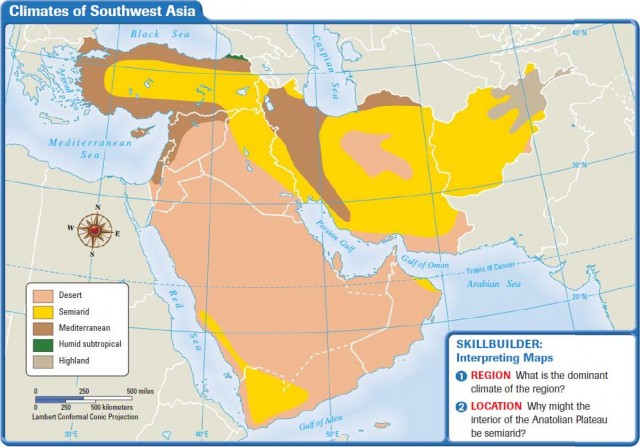Southwest Asia: Climate and Vegetation
A HUMAN PERSPECTIVE In the spring of 1999, three Canadian explorers retraced the steps of Sir Wilfred Thesiger's 1946 epic journey across the Rub al-Khali on the Arabian Peninsula. It is one of the most extreme deserts in the world. Like Sir Wilfred, they crossed using camels, not four-wheel drive vehicles. But unlike Sir Wilfred, the Canadians were equipped with late 20th-century explorers' tools—personal location beacons, a satellite phone for communications, and laptop computers for recording details of the journey. Crossing this great arid expanse was physically challenging and took 40 days to complete. But for many of the region's inhabitants, survival in the lands of this region is a challenge every day.
Variety in Arid Lands
Southwest Asia is extremely arid. Most areas receive less than 18 inches of precipitation a year. A huge portion of its land area is covered with rough, dry terrain that varies from huge tracts of sand dunes to great salt flats. Study the Map Skills on page 494 to learn more about desert vegetation. Because the region is so dry, its rivers do not flow year round. The vegetation and animals living in the desert can survive on little water and in extreme temperatures. In many areas of Southwest Asia, irrigation has transformed the deserts into productive farmland.
In other parts of the region, a Mediterranean climate prevails, making the land green and lush for at least part of each year. The land in Southwest Asia is broken up by ranges of mountains and plateaus. As a result, highland climates are found in many parts of the region.
Deserts Limit Movement
Spread across the region, the deserts effectively reduce travel and limit almost all human-environment interaction. The surfaces of the desert may be covered with sand, salt, or rocks.

SANDY DESERTS
The most famous desert in the region is the Rub al-Khali, also known as the Empty Quarter. A local name for the desert is the “place where no one comes out.” It is a vast desert approximately the size of Texas—on the Arabian Peninsula. It is one of the largest sandy deserts in the world, covering about 250,000 square miles with sand ridges and dunes that reach as high as 800 feet. During the summer, the temperature on the surface of the sand often exceeds 150°F. As many as 10 years may pass without rainfall.
Next to the Rub al-Khali is the An-Nafud Desert. An occasional oasis interrupts its reddish dunes. An oasis is an area in the desert where vegetation is found because water is available, usually from underground springs. Severe sandstorms and brutal heat make this desert a barrier to travel across the Arabian Peninsula.
Extending north from the An-Nafud is the Syrian Desert. It separates the coastal regions of Lebanon, Israel, and Syria from the Tigris and Euphrates valleys. Finally, the desert area that occupies parts of Israel is the Negev Desert. Unlike some deserts, this one produces crops through extensive irrigation.
SALT DESERTS
As you learned in Chapter 3, lands in the rain shadow of a mountain range are usually arid or semiarid. Lands in Iran are good examples of this effect. In Iran, the high mountains block rain, and dry winds increase evaporation. So when winds evaporate the moisture in the soil, chemical salts remain, creating a salt flat. In Iran there are two salt flat deserts—the Dasht-e Kavir in central Iran and the Dasht-e Lut in eastern Iran. The lands here are salt-crusted, surrounded by quicksand-like salt marshes, and extremely hot. These rugged lands are almost uninhabited and are barriers to easy movement across Iran.
Semiarid Lands
On the fringes of the deserts are regions with a semiarid climate. These semiarid areas have warm to hot summers with enough rainfall to support grass and some low-growing shrubs. Both cotton and wheat can be grown in this climate. The lands offer good pasture for animals. In Turkey, large herds of mohair goats graze on these lands. Their hair, and fabrics made from it, are among Turkey's exports.
Well-Watered Coast Lands
Although much of Southwest Asia is arid or semiarid, it does have some areas with adequate rainfall. Along the Mediterranean coast and across most of Turkey, hot summers and rainy winters like those in southern California create a good climate for growing citrus fruits, olives, and vegetables. Because of mild winter temperatures in winter and heavy irrigation in the dry summer, farmers can grow crops year round. The Mediterranean climate is a comfortable one in which to live, so these areas are heavily populated.
For thousands of years, the valleys of the Tigris and Euphrates have been the site of intensive farming. Both Turkey and Iraq have constructed dams on the rivers to provide irrigation water all year long. Climate, vegetation, and landforms have had a major impact on human-environment interaction in Southwest Asia. In the next section, you will see how oil and water have shaped life in this region.